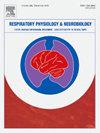非调和形态呼吸测量法对人类呼吸特征的有效性和可靠性。
IF 1.6
4区 医学
Q3 PHYSIOLOGY
引用次数: 0
摘要
诊断和监测呼吸系统疾病通常依赖于肺功能测试,这需要患者的充分合作和训练有素的人员,限制了其适用性。分析自然呼吸提供了一个有价值的选择,但需要新的方法方法。本研究引入了非调和形态学分析,这是一种表征呼吸周期的新技术,并评估了其可靠性和区分健康个体与慢性阻塞性肺疾病(COPD)患者的能力。健康个体20人(男性17人;年龄28岁 ± 5岁;身体质量指数21 ± 2kg/m²)和119例COPD患者(包括所有肺活量计GOLD期)在自然呼吸时使用线性肺记录仪进行研究。使用非调和形态学分析分析通气流量痕迹,从而能够重建每个个体的平均通气周期(个人呼吸谱,PRP)。通过计算prp之间的欧几里得距离进行比较。非调和形态分析使通气周期的精确和可重复的特征。PRPs具有较高的时间稳定性。基于欧几里得距离的细分区分健康个体和COPD患者的敏感性为86%,特异性为94%。探索性分析进一步表明,该方法可以根据吸气量的变化来识别COPD患者对支气管扩张剂的反应。非调和形态分析提供了一种可重复的,生理上有意义的自然呼吸描述,并显示了未来发展的希望,作为一种基于自发呼吸的工具,帮助诊断呼吸系统疾病,而不需要患者的合作。本文章由计算机程序翻译,如有差异,请以英文原文为准。
Validity and reliability of anharmonic morphological ventilometry for the characterisation of human breathing
Diagnosing and monitoring respiratory disorders typically rely on pulmonary function testing, which requires full patient cooperation and trained personnel, limiting its applicability. Analysing natural breathing offers a valuable alternative but requires new methodological approaches. This study introduces anharmonic morphological analysis, a novel technique to characterise breathing cycles, and evaluates its reliability and ability to distinguish healthy individuals from patients with chronic obstructive pulmonary disease (COPD). Twenty healthy individuals (17 men; age 28 ± 5 years; body mass index 21 ± 2 kg/m²) and 119 COPD patients (covering all spirometric GOLD stages) were studied during natural breathing using a linear pneumotachograph. Ventilatory flow traces were analysed using anharmonic morphological analysis, enabling the reconstruction of an average ventilatory cycle for each individual (personal respiratory profile, PRP). Comparisons were performed by calculating Euclidean distances between PRPs. Anharmonic morphological analysis enabled precise and reproducible characterisation of ventilatory cycles. PRPs showed high temporal stability. Tessellation based on Euclidean distances distinguished healthy individuals from COPD patients with a sensitivity of 86 % and a specificity of 94 %. Exploratory analyses further suggested the potential of the method to identify COPD patients responsive to bronchodilator administration based on inspiratory capacity changes. Anharmonic morphological analysis offers a reproducible, physiologically meaningful description of natural breathing and shows promise for future development as a spontaneous-breathing-based tool to assist in diagnosing respiratory disorders without requiring patient cooperation.
求助全文
通过发布文献求助,成功后即可免费获取论文全文。
去求助
来源期刊
CiteScore
4.80
自引率
8.70%
发文量
104
审稿时长
54 days
期刊介绍:
Respiratory Physiology & Neurobiology (RESPNB) publishes original articles and invited reviews concerning physiology and pathophysiology of respiration in its broadest sense.
Although a special focus is on topics in neurobiology, high quality papers in respiratory molecular and cellular biology are also welcome, as are high-quality papers in traditional areas, such as:
-Mechanics of breathing-
Gas exchange and acid-base balance-
Respiration at rest and exercise-
Respiration in unusual conditions, like high or low pressure or changes of temperature, low ambient oxygen-
Embryonic and adult respiration-
Comparative respiratory physiology.
Papers on clinical aspects, original methods, as well as theoretical papers are also considered as long as they foster the understanding of respiratory physiology and pathophysiology.

 求助内容:
求助内容: 应助结果提醒方式:
应助结果提醒方式:


